SNPG925: Transformational Leadership in Healthcare Sector
VerifiedAdded on 2022/10/19
|11
|2414
|66
Report
AI Summary
This report examines the influence of transformational leadership within the healthcare sector, focusing on its impact at the individual, team, and service levels. It highlights the shift from traditional leadership styles to transformational approaches that empower employees and encourage participation in decision-making. The analysis covers how transformational leadership fosters vision, transparency, and employee engagement, leading to improved team performance, innovation, and service delivery. The report also acknowledges the need for a balance between transformational and autocratic approaches in healthcare, emphasizing the importance of guided actions and supervision in critical situations. Ultimately, the report concludes that transformational leadership is crucial for driving operational excellence and value creation in the healthcare sector.

ASSESSMENT 2
Paraphrase This Document
Need a fresh take? Get an instant paraphrase of this document with our AI Paraphraser
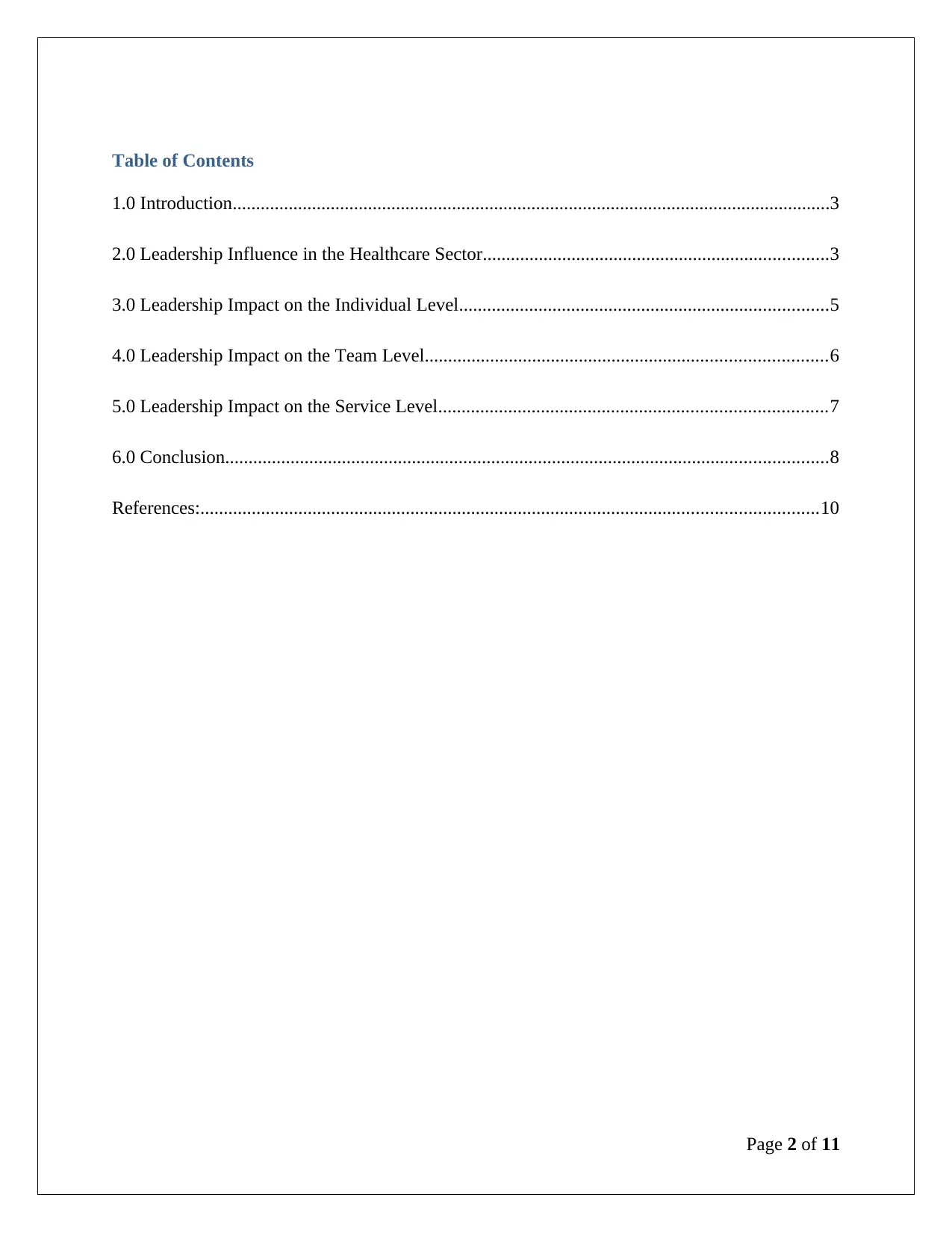
Table of Contents
1.0 Introduction................................................................................................................................3
2.0 Leadership Influence in the Healthcare Sector..........................................................................3
3.0 Leadership Impact on the Individual Level...............................................................................5
4.0 Leadership Impact on the Team Level......................................................................................6
5.0 Leadership Impact on the Service Level...................................................................................7
6.0 Conclusion.................................................................................................................................8
References:....................................................................................................................................10
Page 2 of 11
1.0 Introduction................................................................................................................................3
2.0 Leadership Influence in the Healthcare Sector..........................................................................3
3.0 Leadership Impact on the Individual Level...............................................................................5
4.0 Leadership Impact on the Team Level......................................................................................6
5.0 Leadership Impact on the Service Level...................................................................................7
6.0 Conclusion.................................................................................................................................8
References:....................................................................................................................................10
Page 2 of 11
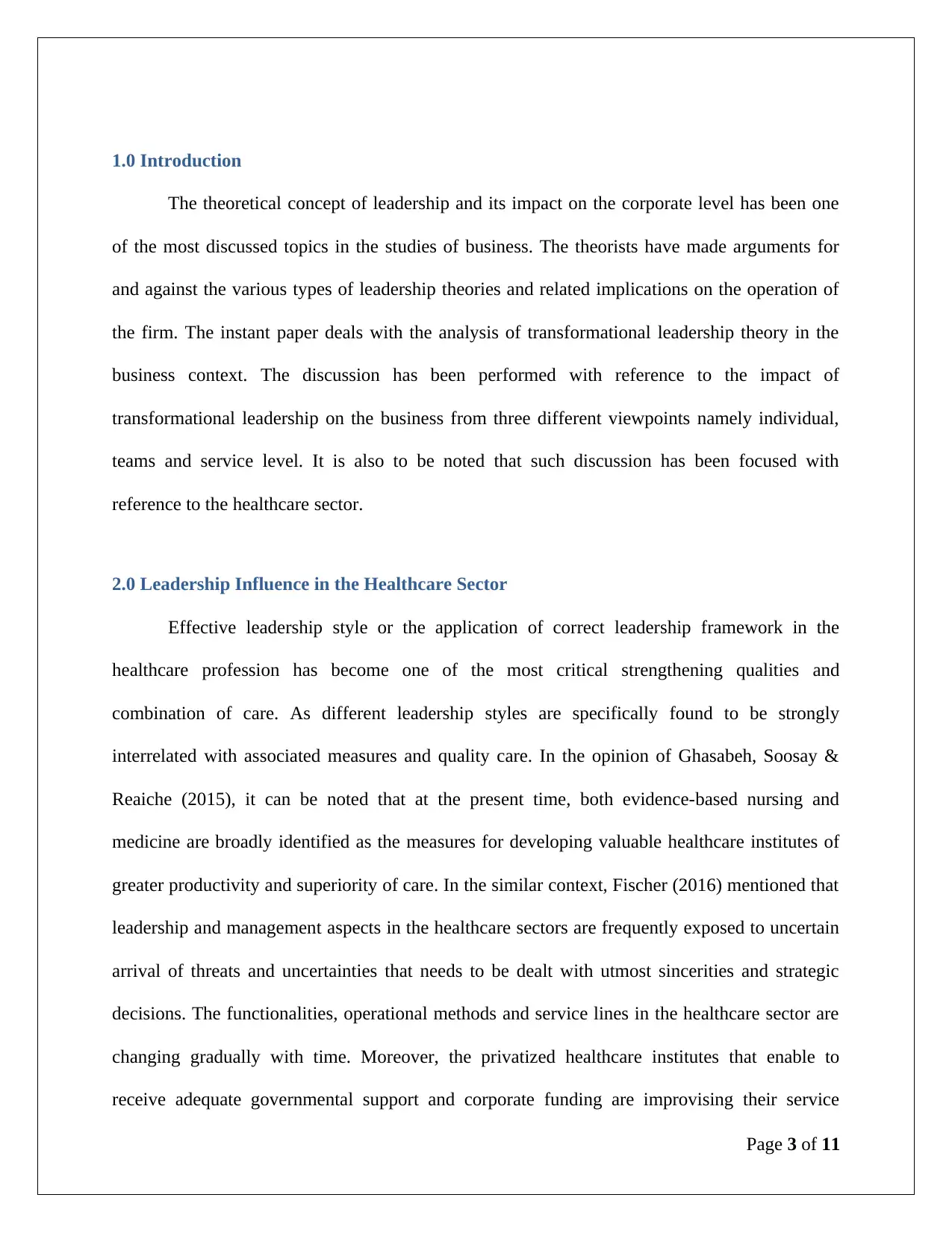
1.0 Introduction
The theoretical concept of leadership and its impact on the corporate level has been one
of the most discussed topics in the studies of business. The theorists have made arguments for
and against the various types of leadership theories and related implications on the operation of
the firm. The instant paper deals with the analysis of transformational leadership theory in the
business context. The discussion has been performed with reference to the impact of
transformational leadership on the business from three different viewpoints namely individual,
teams and service level. It is also to be noted that such discussion has been focused with
reference to the healthcare sector.
2.0 Leadership Influence in the Healthcare Sector
Effective leadership style or the application of correct leadership framework in the
healthcare profession has become one of the most critical strengthening qualities and
combination of care. As different leadership styles are specifically found to be strongly
interrelated with associated measures and quality care. In the opinion of Ghasabeh, Soosay &
Reaiche (2015), it can be noted that at the present time, both evidence-based nursing and
medicine are broadly identified as the measures for developing valuable healthcare institutes of
greater productivity and superiority of care. In the similar context, Fischer (2016) mentioned that
leadership and management aspects in the healthcare sectors are frequently exposed to uncertain
arrival of threats and uncertainties that needs to be dealt with utmost sincerities and strategic
decisions. The functionalities, operational methods and service lines in the healthcare sector are
changing gradually with time. Moreover, the privatized healthcare institutes that enable to
receive adequate governmental support and corporate funding are improvising their service
Page 3 of 11
The theoretical concept of leadership and its impact on the corporate level has been one
of the most discussed topics in the studies of business. The theorists have made arguments for
and against the various types of leadership theories and related implications on the operation of
the firm. The instant paper deals with the analysis of transformational leadership theory in the
business context. The discussion has been performed with reference to the impact of
transformational leadership on the business from three different viewpoints namely individual,
teams and service level. It is also to be noted that such discussion has been focused with
reference to the healthcare sector.
2.0 Leadership Influence in the Healthcare Sector
Effective leadership style or the application of correct leadership framework in the
healthcare profession has become one of the most critical strengthening qualities and
combination of care. As different leadership styles are specifically found to be strongly
interrelated with associated measures and quality care. In the opinion of Ghasabeh, Soosay &
Reaiche (2015), it can be noted that at the present time, both evidence-based nursing and
medicine are broadly identified as the measures for developing valuable healthcare institutes of
greater productivity and superiority of care. In the similar context, Fischer (2016) mentioned that
leadership and management aspects in the healthcare sectors are frequently exposed to uncertain
arrival of threats and uncertainties that needs to be dealt with utmost sincerities and strategic
decisions. The functionalities, operational methods and service lines in the healthcare sector are
changing gradually with time. Moreover, the privatized healthcare institutes that enable to
receive adequate governmental support and corporate funding are improvising their service
Page 3 of 11
⊘ This is a preview!⊘
Do you want full access?
Subscribe today to unlock all pages.

Trusted by 1+ million students worldwide
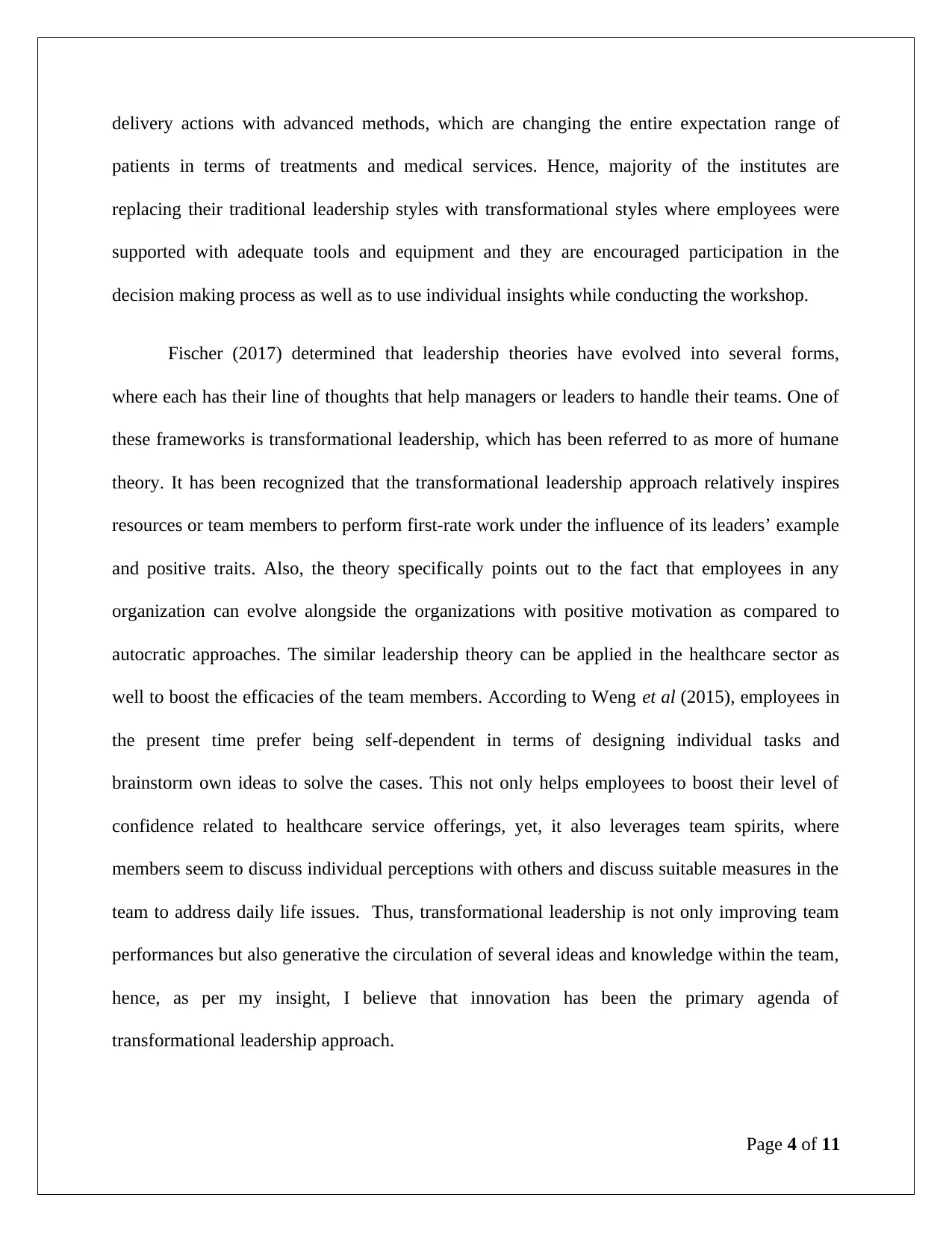
delivery actions with advanced methods, which are changing the entire expectation range of
patients in terms of treatments and medical services. Hence, majority of the institutes are
replacing their traditional leadership styles with transformational styles where employees were
supported with adequate tools and equipment and they are encouraged participation in the
decision making process as well as to use individual insights while conducting the workshop.
Fischer (2017) determined that leadership theories have evolved into several forms,
where each has their line of thoughts that help managers or leaders to handle their teams. One of
these frameworks is transformational leadership, which has been referred to as more of humane
theory. It has been recognized that the transformational leadership approach relatively inspires
resources or team members to perform first-rate work under the influence of its leaders’ example
and positive traits. Also, the theory specifically points out to the fact that employees in any
organization can evolve alongside the organizations with positive motivation as compared to
autocratic approaches. The similar leadership theory can be applied in the healthcare sector as
well to boost the efficacies of the team members. According to Weng et al (2015), employees in
the present time prefer being self-dependent in terms of designing individual tasks and
brainstorm own ideas to solve the cases. This not only helps employees to boost their level of
confidence related to healthcare service offerings, yet, it also leverages team spirits, where
members seem to discuss individual perceptions with others and discuss suitable measures in the
team to address daily life issues. Thus, transformational leadership is not only improving team
performances but also generative the circulation of several ideas and knowledge within the team,
hence, as per my insight, I believe that innovation has been the primary agenda of
transformational leadership approach.
Page 4 of 11
patients in terms of treatments and medical services. Hence, majority of the institutes are
replacing their traditional leadership styles with transformational styles where employees were
supported with adequate tools and equipment and they are encouraged participation in the
decision making process as well as to use individual insights while conducting the workshop.
Fischer (2017) determined that leadership theories have evolved into several forms,
where each has their line of thoughts that help managers or leaders to handle their teams. One of
these frameworks is transformational leadership, which has been referred to as more of humane
theory. It has been recognized that the transformational leadership approach relatively inspires
resources or team members to perform first-rate work under the influence of its leaders’ example
and positive traits. Also, the theory specifically points out to the fact that employees in any
organization can evolve alongside the organizations with positive motivation as compared to
autocratic approaches. The similar leadership theory can be applied in the healthcare sector as
well to boost the efficacies of the team members. According to Weng et al (2015), employees in
the present time prefer being self-dependent in terms of designing individual tasks and
brainstorm own ideas to solve the cases. This not only helps employees to boost their level of
confidence related to healthcare service offerings, yet, it also leverages team spirits, where
members seem to discuss individual perceptions with others and discuss suitable measures in the
team to address daily life issues. Thus, transformational leadership is not only improving team
performances but also generative the circulation of several ideas and knowledge within the team,
hence, as per my insight, I believe that innovation has been the primary agenda of
transformational leadership approach.
Page 4 of 11
Paraphrase This Document
Need a fresh take? Get an instant paraphrase of this document with our AI Paraphraser
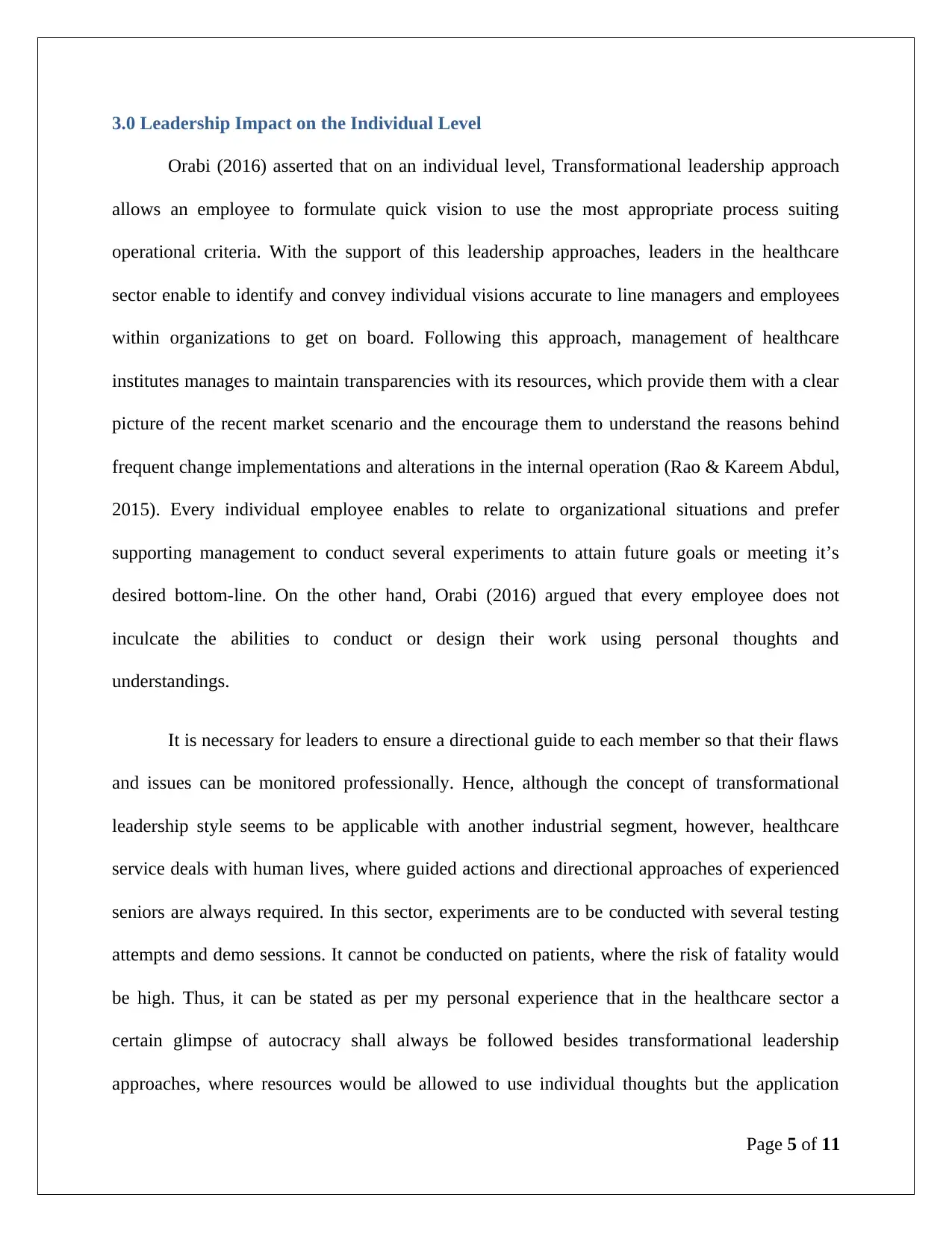
3.0 Leadership Impact on the Individual Level
Orabi (2016) asserted that on an individual level, Transformational leadership approach
allows an employee to formulate quick vision to use the most appropriate process suiting
operational criteria. With the support of this leadership approaches, leaders in the healthcare
sector enable to identify and convey individual visions accurate to line managers and employees
within organizations to get on board. Following this approach, management of healthcare
institutes manages to maintain transparencies with its resources, which provide them with a clear
picture of the recent market scenario and the encourage them to understand the reasons behind
frequent change implementations and alterations in the internal operation (Rao & Kareem Abdul,
2015). Every individual employee enables to relate to organizational situations and prefer
supporting management to conduct several experiments to attain future goals or meeting it’s
desired bottom-line. On the other hand, Orabi (2016) argued that every employee does not
inculcate the abilities to conduct or design their work using personal thoughts and
understandings.
It is necessary for leaders to ensure a directional guide to each member so that their flaws
and issues can be monitored professionally. Hence, although the concept of transformational
leadership style seems to be applicable with another industrial segment, however, healthcare
service deals with human lives, where guided actions and directional approaches of experienced
seniors are always required. In this sector, experiments are to be conducted with several testing
attempts and demo sessions. It cannot be conducted on patients, where the risk of fatality would
be high. Thus, it can be stated as per my personal experience that in the healthcare sector a
certain glimpse of autocracy shall always be followed besides transformational leadership
approaches, where resources would be allowed to use individual thoughts but the application
Page 5 of 11
Orabi (2016) asserted that on an individual level, Transformational leadership approach
allows an employee to formulate quick vision to use the most appropriate process suiting
operational criteria. With the support of this leadership approaches, leaders in the healthcare
sector enable to identify and convey individual visions accurate to line managers and employees
within organizations to get on board. Following this approach, management of healthcare
institutes manages to maintain transparencies with its resources, which provide them with a clear
picture of the recent market scenario and the encourage them to understand the reasons behind
frequent change implementations and alterations in the internal operation (Rao & Kareem Abdul,
2015). Every individual employee enables to relate to organizational situations and prefer
supporting management to conduct several experiments to attain future goals or meeting it’s
desired bottom-line. On the other hand, Orabi (2016) argued that every employee does not
inculcate the abilities to conduct or design their work using personal thoughts and
understandings.
It is necessary for leaders to ensure a directional guide to each member so that their flaws
and issues can be monitored professionally. Hence, although the concept of transformational
leadership style seems to be applicable with another industrial segment, however, healthcare
service deals with human lives, where guided actions and directional approaches of experienced
seniors are always required. In this sector, experiments are to be conducted with several testing
attempts and demo sessions. It cannot be conducted on patients, where the risk of fatality would
be high. Thus, it can be stated as per my personal experience that in the healthcare sector a
certain glimpse of autocracy shall always be followed besides transformational leadership
approaches, where resources would be allowed to use individual thoughts but the application
Page 5 of 11
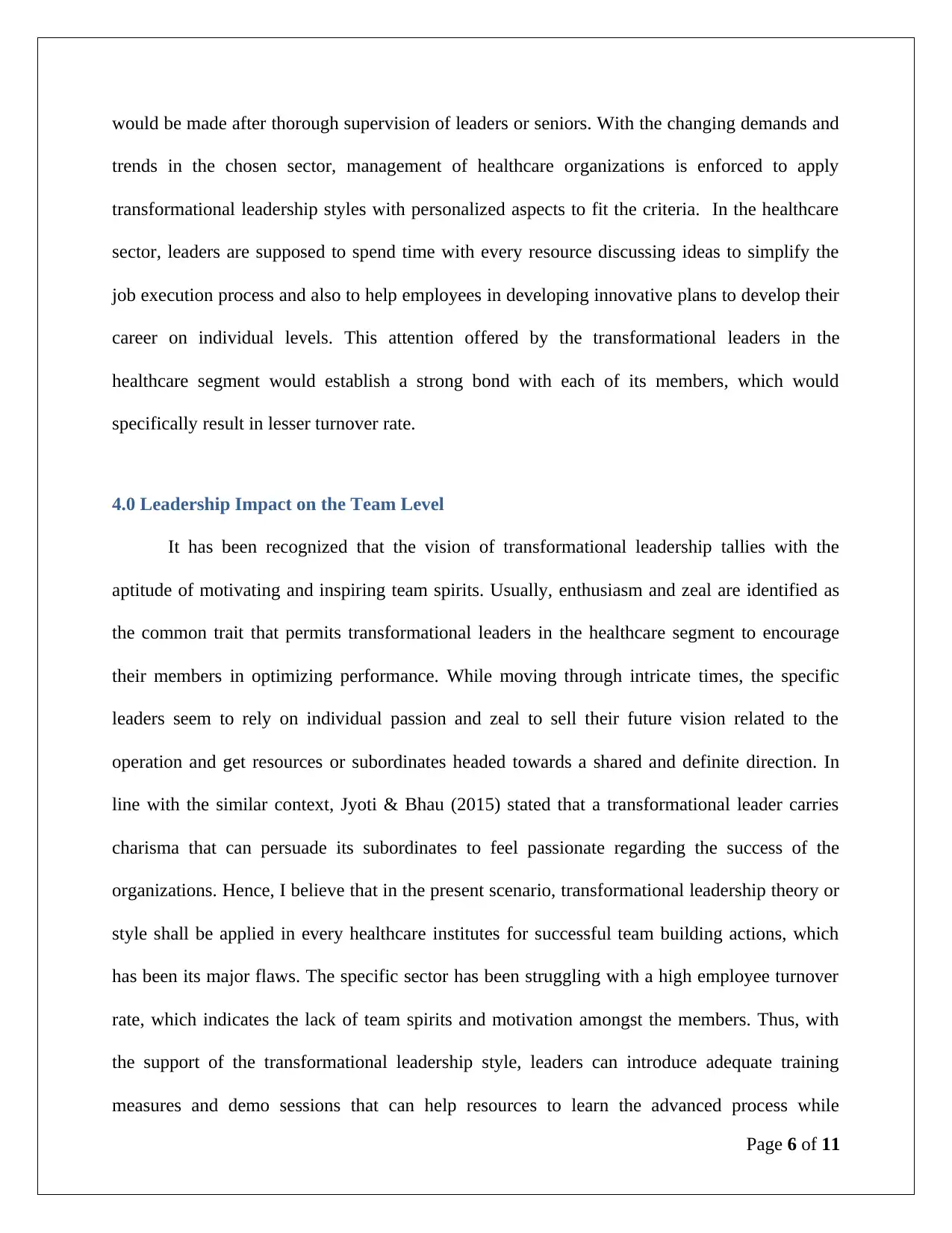
would be made after thorough supervision of leaders or seniors. With the changing demands and
trends in the chosen sector, management of healthcare organizations is enforced to apply
transformational leadership styles with personalized aspects to fit the criteria. In the healthcare
sector, leaders are supposed to spend time with every resource discussing ideas to simplify the
job execution process and also to help employees in developing innovative plans to develop their
career on individual levels. This attention offered by the transformational leaders in the
healthcare segment would establish a strong bond with each of its members, which would
specifically result in lesser turnover rate.
4.0 Leadership Impact on the Team Level
It has been recognized that the vision of transformational leadership tallies with the
aptitude of motivating and inspiring team spirits. Usually, enthusiasm and zeal are identified as
the common trait that permits transformational leaders in the healthcare segment to encourage
their members in optimizing performance. While moving through intricate times, the specific
leaders seem to rely on individual passion and zeal to sell their future vision related to the
operation and get resources or subordinates headed towards a shared and definite direction. In
line with the similar context, Jyoti & Bhau (2015) stated that a transformational leader carries
charisma that can persuade its subordinates to feel passionate regarding the success of the
organizations. Hence, I believe that in the present scenario, transformational leadership theory or
style shall be applied in every healthcare institutes for successful team building actions, which
has been its major flaws. The specific sector has been struggling with a high employee turnover
rate, which indicates the lack of team spirits and motivation amongst the members. Thus, with
the support of the transformational leadership style, leaders can introduce adequate training
measures and demo sessions that can help resources to learn the advanced process while
Page 6 of 11
trends in the chosen sector, management of healthcare organizations is enforced to apply
transformational leadership styles with personalized aspects to fit the criteria. In the healthcare
sector, leaders are supposed to spend time with every resource discussing ideas to simplify the
job execution process and also to help employees in developing innovative plans to develop their
career on individual levels. This attention offered by the transformational leaders in the
healthcare segment would establish a strong bond with each of its members, which would
specifically result in lesser turnover rate.
4.0 Leadership Impact on the Team Level
It has been recognized that the vision of transformational leadership tallies with the
aptitude of motivating and inspiring team spirits. Usually, enthusiasm and zeal are identified as
the common trait that permits transformational leaders in the healthcare segment to encourage
their members in optimizing performance. While moving through intricate times, the specific
leaders seem to rely on individual passion and zeal to sell their future vision related to the
operation and get resources or subordinates headed towards a shared and definite direction. In
line with the similar context, Jyoti & Bhau (2015) stated that a transformational leader carries
charisma that can persuade its subordinates to feel passionate regarding the success of the
organizations. Hence, I believe that in the present scenario, transformational leadership theory or
style shall be applied in every healthcare institutes for successful team building actions, which
has been its major flaws. The specific sector has been struggling with a high employee turnover
rate, which indicates the lack of team spirits and motivation amongst the members. Thus, with
the support of the transformational leadership style, leaders can introduce adequate training
measures and demo sessions that can help resources to learn the advanced process while
Page 6 of 11
⊘ This is a preview!⊘
Do you want full access?
Subscribe today to unlock all pages.

Trusted by 1+ million students worldwide
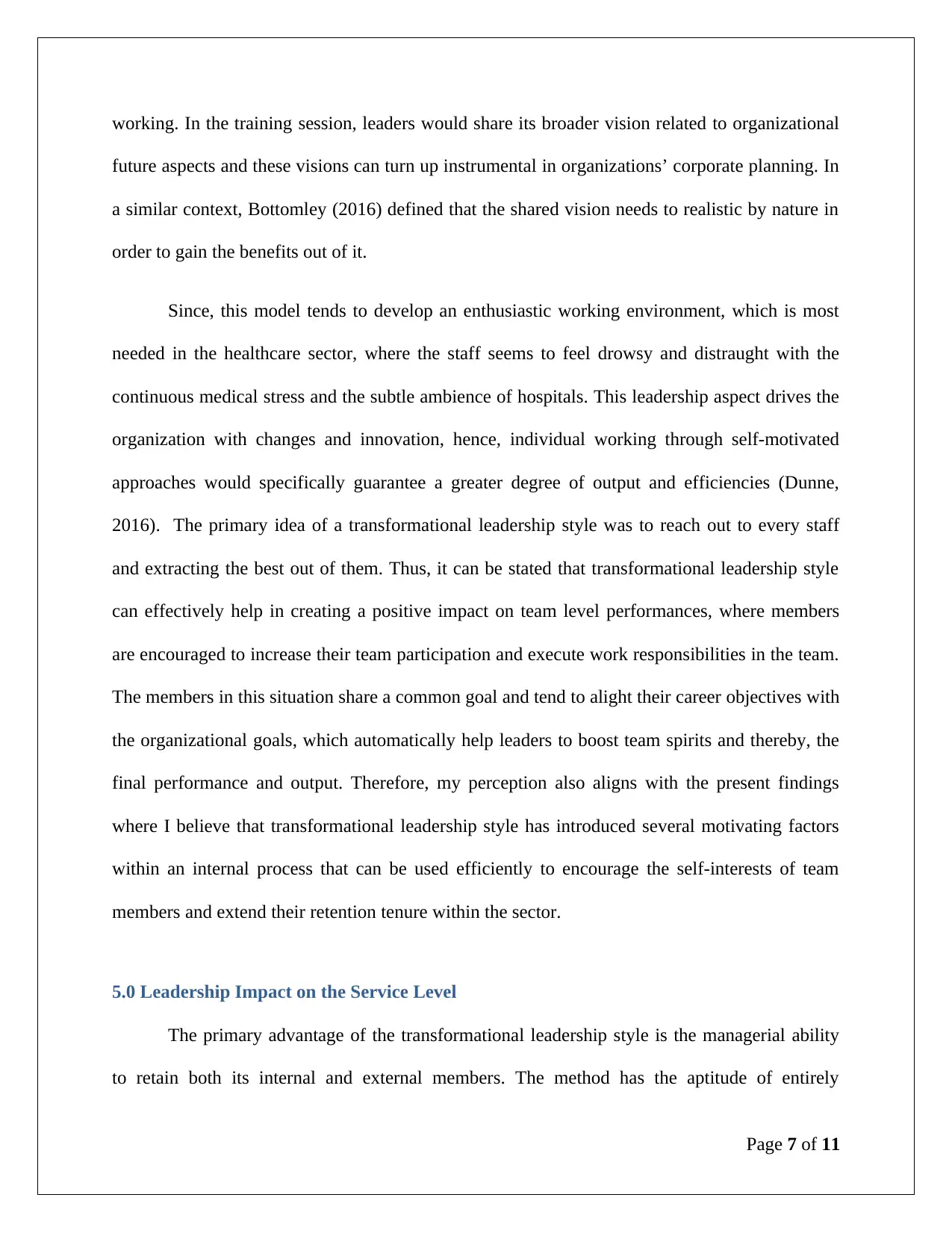
working. In the training session, leaders would share its broader vision related to organizational
future aspects and these visions can turn up instrumental in organizations’ corporate planning. In
a similar context, Bottomley (2016) defined that the shared vision needs to realistic by nature in
order to gain the benefits out of it.
Since, this model tends to develop an enthusiastic working environment, which is most
needed in the healthcare sector, where the staff seems to feel drowsy and distraught with the
continuous medical stress and the subtle ambience of hospitals. This leadership aspect drives the
organization with changes and innovation, hence, individual working through self-motivated
approaches would specifically guarantee a greater degree of output and efficiencies (Dunne,
2016). The primary idea of a transformational leadership style was to reach out to every staff
and extracting the best out of them. Thus, it can be stated that transformational leadership style
can effectively help in creating a positive impact on team level performances, where members
are encouraged to increase their team participation and execute work responsibilities in the team.
The members in this situation share a common goal and tend to alight their career objectives with
the organizational goals, which automatically help leaders to boost team spirits and thereby, the
final performance and output. Therefore, my perception also aligns with the present findings
where I believe that transformational leadership style has introduced several motivating factors
within an internal process that can be used efficiently to encourage the self-interests of team
members and extend their retention tenure within the sector.
5.0 Leadership Impact on the Service Level
The primary advantage of the transformational leadership style is the managerial ability
to retain both its internal and external members. The method has the aptitude of entirely
Page 7 of 11
future aspects and these visions can turn up instrumental in organizations’ corporate planning. In
a similar context, Bottomley (2016) defined that the shared vision needs to realistic by nature in
order to gain the benefits out of it.
Since, this model tends to develop an enthusiastic working environment, which is most
needed in the healthcare sector, where the staff seems to feel drowsy and distraught with the
continuous medical stress and the subtle ambience of hospitals. This leadership aspect drives the
organization with changes and innovation, hence, individual working through self-motivated
approaches would specifically guarantee a greater degree of output and efficiencies (Dunne,
2016). The primary idea of a transformational leadership style was to reach out to every staff
and extracting the best out of them. Thus, it can be stated that transformational leadership style
can effectively help in creating a positive impact on team level performances, where members
are encouraged to increase their team participation and execute work responsibilities in the team.
The members in this situation share a common goal and tend to alight their career objectives with
the organizational goals, which automatically help leaders to boost team spirits and thereby, the
final performance and output. Therefore, my perception also aligns with the present findings
where I believe that transformational leadership style has introduced several motivating factors
within an internal process that can be used efficiently to encourage the self-interests of team
members and extend their retention tenure within the sector.
5.0 Leadership Impact on the Service Level
The primary advantage of the transformational leadership style is the managerial ability
to retain both its internal and external members. The method has the aptitude of entirely
Page 7 of 11
Paraphrase This Document
Need a fresh take? Get an instant paraphrase of this document with our AI Paraphraser
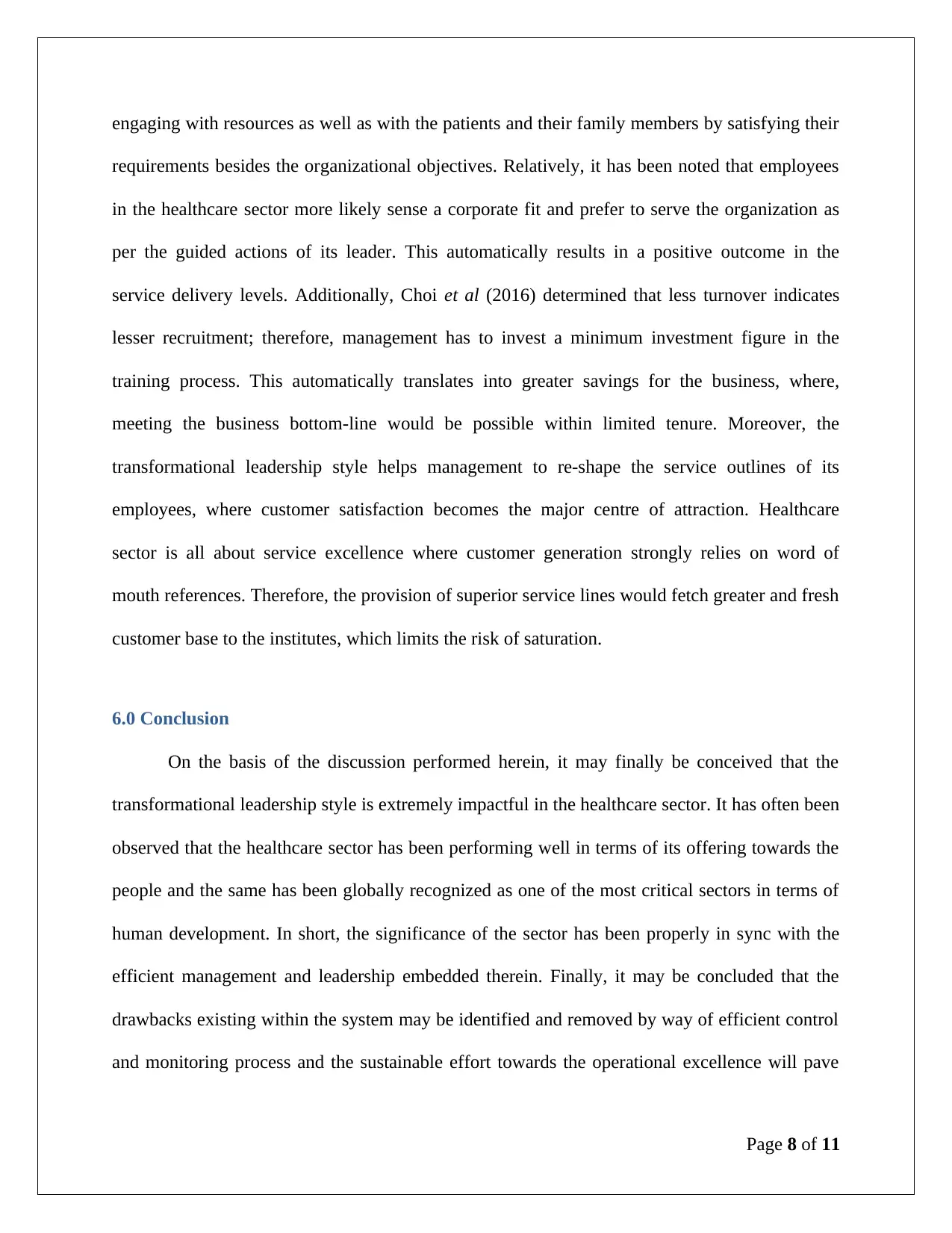
engaging with resources as well as with the patients and their family members by satisfying their
requirements besides the organizational objectives. Relatively, it has been noted that employees
in the healthcare sector more likely sense a corporate fit and prefer to serve the organization as
per the guided actions of its leader. This automatically results in a positive outcome in the
service delivery levels. Additionally, Choi et al (2016) determined that less turnover indicates
lesser recruitment; therefore, management has to invest a minimum investment figure in the
training process. This automatically translates into greater savings for the business, where,
meeting the business bottom-line would be possible within limited tenure. Moreover, the
transformational leadership style helps management to re-shape the service outlines of its
employees, where customer satisfaction becomes the major centre of attraction. Healthcare
sector is all about service excellence where customer generation strongly relies on word of
mouth references. Therefore, the provision of superior service lines would fetch greater and fresh
customer base to the institutes, which limits the risk of saturation.
6.0 Conclusion
On the basis of the discussion performed herein, it may finally be conceived that the
transformational leadership style is extremely impactful in the healthcare sector. It has often been
observed that the healthcare sector has been performing well in terms of its offering towards the
people and the same has been globally recognized as one of the most critical sectors in terms of
human development. In short, the significance of the sector has been properly in sync with the
efficient management and leadership embedded therein. Finally, it may be concluded that the
drawbacks existing within the system may be identified and removed by way of efficient control
and monitoring process and the sustainable effort towards the operational excellence will pave
Page 8 of 11
requirements besides the organizational objectives. Relatively, it has been noted that employees
in the healthcare sector more likely sense a corporate fit and prefer to serve the organization as
per the guided actions of its leader. This automatically results in a positive outcome in the
service delivery levels. Additionally, Choi et al (2016) determined that less turnover indicates
lesser recruitment; therefore, management has to invest a minimum investment figure in the
training process. This automatically translates into greater savings for the business, where,
meeting the business bottom-line would be possible within limited tenure. Moreover, the
transformational leadership style helps management to re-shape the service outlines of its
employees, where customer satisfaction becomes the major centre of attraction. Healthcare
sector is all about service excellence where customer generation strongly relies on word of
mouth references. Therefore, the provision of superior service lines would fetch greater and fresh
customer base to the institutes, which limits the risk of saturation.
6.0 Conclusion
On the basis of the discussion performed herein, it may finally be conceived that the
transformational leadership style is extremely impactful in the healthcare sector. It has often been
observed that the healthcare sector has been performing well in terms of its offering towards the
people and the same has been globally recognized as one of the most critical sectors in terms of
human development. In short, the significance of the sector has been properly in sync with the
efficient management and leadership embedded therein. Finally, it may be concluded that the
drawbacks existing within the system may be identified and removed by way of efficient control
and monitoring process and the sustainable effort towards the operational excellence will pave
Page 8 of 11

the long way towards the attainment of pre-set goal of value creation in the healthcare sector
globally through efficient transformational leadership in most optimum manner.
Page 9 of 11
globally through efficient transformational leadership in most optimum manner.
Page 9 of 11
⊘ This is a preview!⊘
Do you want full access?
Subscribe today to unlock all pages.

Trusted by 1+ million students worldwide
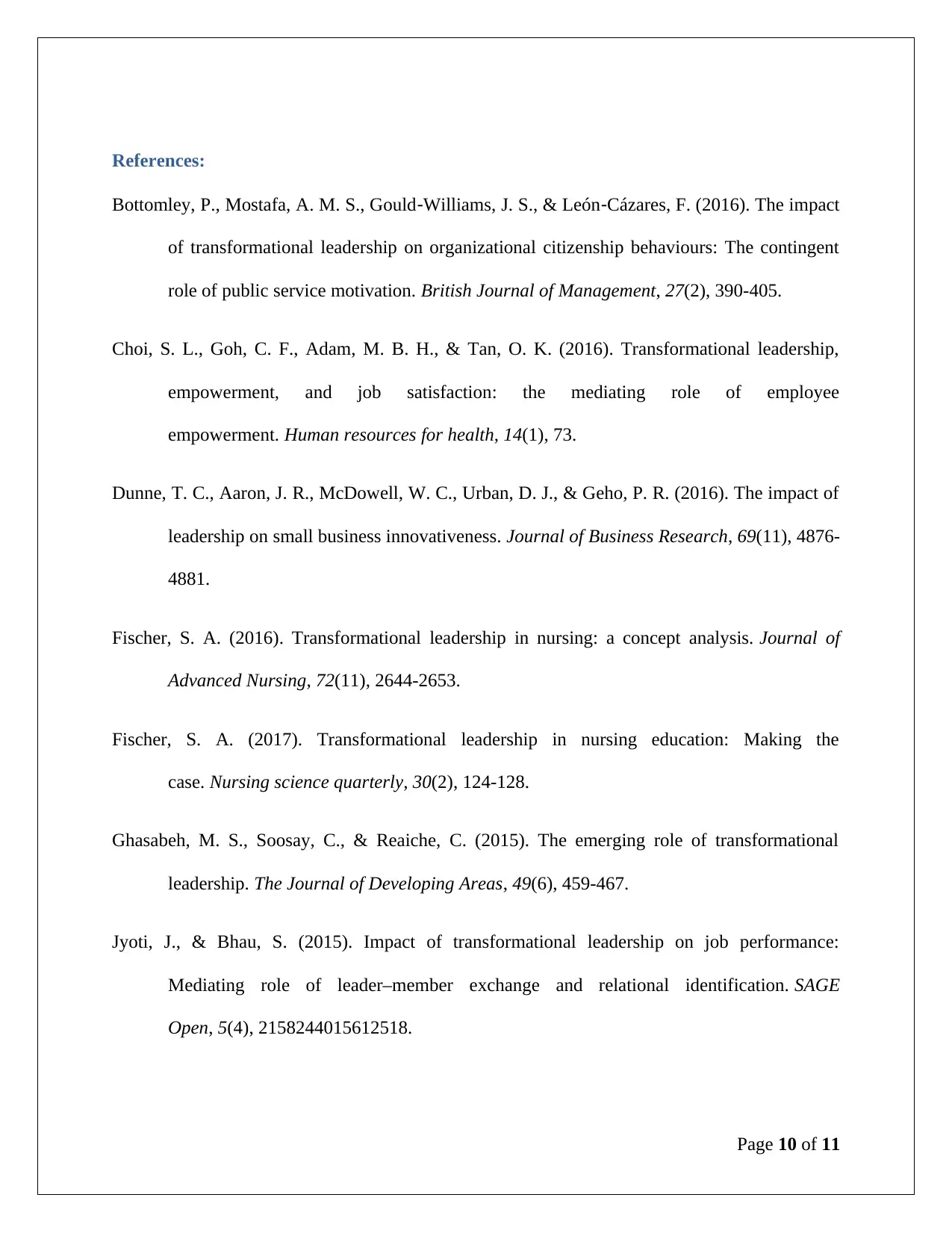
References:
Bottomley, P., Mostafa, A. M. S., Gould‐Williams, J. S., & León‐Cázares, F. (2016). The impact
of transformational leadership on organizational citizenship behaviours: The contingent
role of public service motivation. British Journal of Management, 27(2), 390-405.
Choi, S. L., Goh, C. F., Adam, M. B. H., & Tan, O. K. (2016). Transformational leadership,
empowerment, and job satisfaction: the mediating role of employee
empowerment. Human resources for health, 14(1), 73.
Dunne, T. C., Aaron, J. R., McDowell, W. C., Urban, D. J., & Geho, P. R. (2016). The impact of
leadership on small business innovativeness. Journal of Business Research, 69(11), 4876-
4881.
Fischer, S. A. (2016). Transformational leadership in nursing: a concept analysis. Journal of
Advanced Nursing, 72(11), 2644-2653.
Fischer, S. A. (2017). Transformational leadership in nursing education: Making the
case. Nursing science quarterly, 30(2), 124-128.
Ghasabeh, M. S., Soosay, C., & Reaiche, C. (2015). The emerging role of transformational
leadership. The Journal of Developing Areas, 49(6), 459-467.
Jyoti, J., & Bhau, S. (2015). Impact of transformational leadership on job performance:
Mediating role of leader–member exchange and relational identification. SAGE
Open, 5(4), 2158244015612518.
Page 10 of 11
Bottomley, P., Mostafa, A. M. S., Gould‐Williams, J. S., & León‐Cázares, F. (2016). The impact
of transformational leadership on organizational citizenship behaviours: The contingent
role of public service motivation. British Journal of Management, 27(2), 390-405.
Choi, S. L., Goh, C. F., Adam, M. B. H., & Tan, O. K. (2016). Transformational leadership,
empowerment, and job satisfaction: the mediating role of employee
empowerment. Human resources for health, 14(1), 73.
Dunne, T. C., Aaron, J. R., McDowell, W. C., Urban, D. J., & Geho, P. R. (2016). The impact of
leadership on small business innovativeness. Journal of Business Research, 69(11), 4876-
4881.
Fischer, S. A. (2016). Transformational leadership in nursing: a concept analysis. Journal of
Advanced Nursing, 72(11), 2644-2653.
Fischer, S. A. (2017). Transformational leadership in nursing education: Making the
case. Nursing science quarterly, 30(2), 124-128.
Ghasabeh, M. S., Soosay, C., & Reaiche, C. (2015). The emerging role of transformational
leadership. The Journal of Developing Areas, 49(6), 459-467.
Jyoti, J., & Bhau, S. (2015). Impact of transformational leadership on job performance:
Mediating role of leader–member exchange and relational identification. SAGE
Open, 5(4), 2158244015612518.
Page 10 of 11
Paraphrase This Document
Need a fresh take? Get an instant paraphrase of this document with our AI Paraphraser
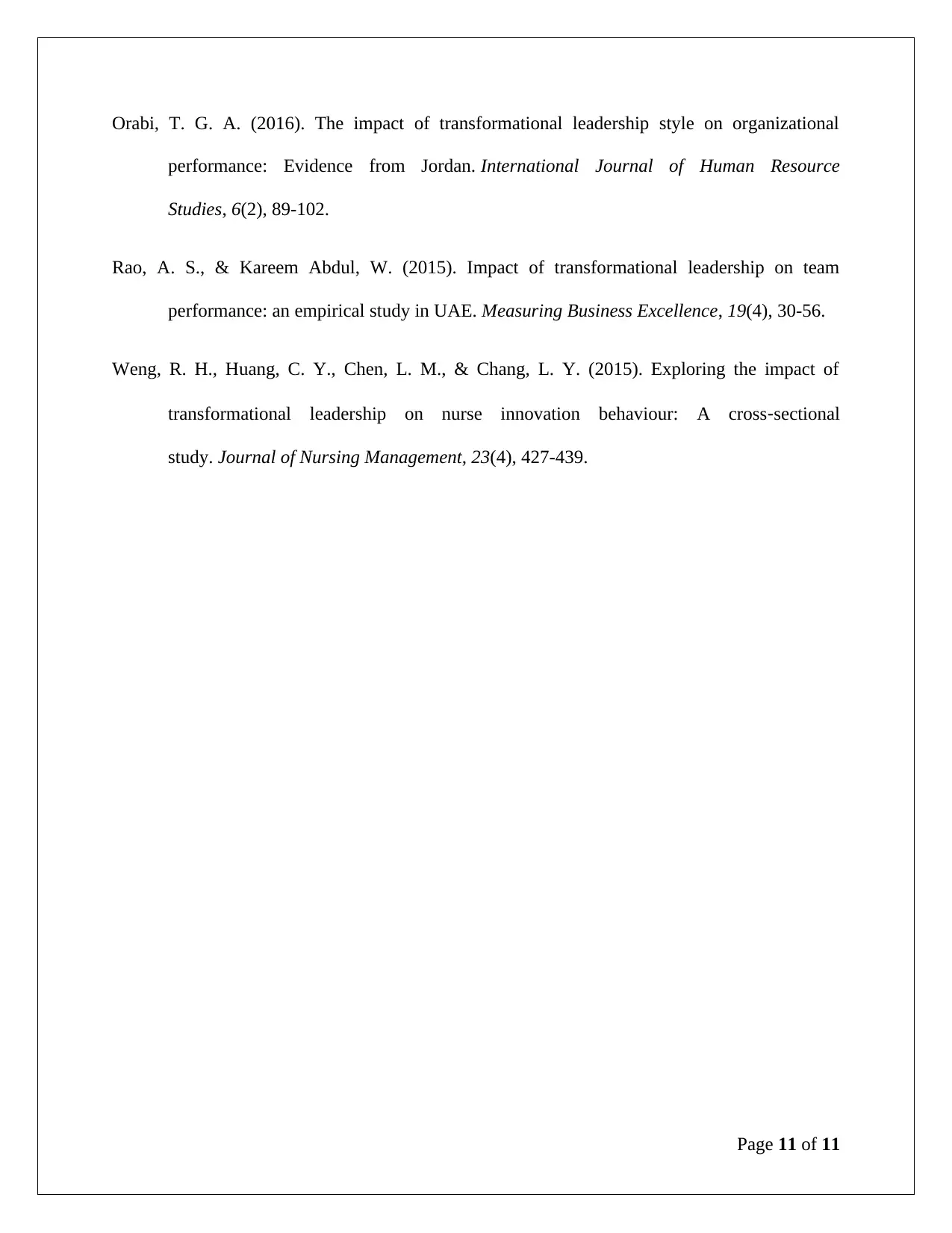
Orabi, T. G. A. (2016). The impact of transformational leadership style on organizational
performance: Evidence from Jordan. International Journal of Human Resource
Studies, 6(2), 89-102.
Rao, A. S., & Kareem Abdul, W. (2015). Impact of transformational leadership on team
performance: an empirical study in UAE. Measuring Business Excellence, 19(4), 30-56.
Weng, R. H., Huang, C. Y., Chen, L. M., & Chang, L. Y. (2015). Exploring the impact of
transformational leadership on nurse innovation behaviour: A cross‐sectional
study. Journal of Nursing Management, 23(4), 427-439.
Page 11 of 11
performance: Evidence from Jordan. International Journal of Human Resource
Studies, 6(2), 89-102.
Rao, A. S., & Kareem Abdul, W. (2015). Impact of transformational leadership on team
performance: an empirical study in UAE. Measuring Business Excellence, 19(4), 30-56.
Weng, R. H., Huang, C. Y., Chen, L. M., & Chang, L. Y. (2015). Exploring the impact of
transformational leadership on nurse innovation behaviour: A cross‐sectional
study. Journal of Nursing Management, 23(4), 427-439.
Page 11 of 11
1 out of 11
Related Documents
Your All-in-One AI-Powered Toolkit for Academic Success.
+13062052269
info@desklib.com
Available 24*7 on WhatsApp / Email
![[object Object]](/_next/static/media/star-bottom.7253800d.svg)
Unlock your academic potential
Copyright © 2020–2025 A2Z Services. All Rights Reserved. Developed and managed by ZUCOL.





